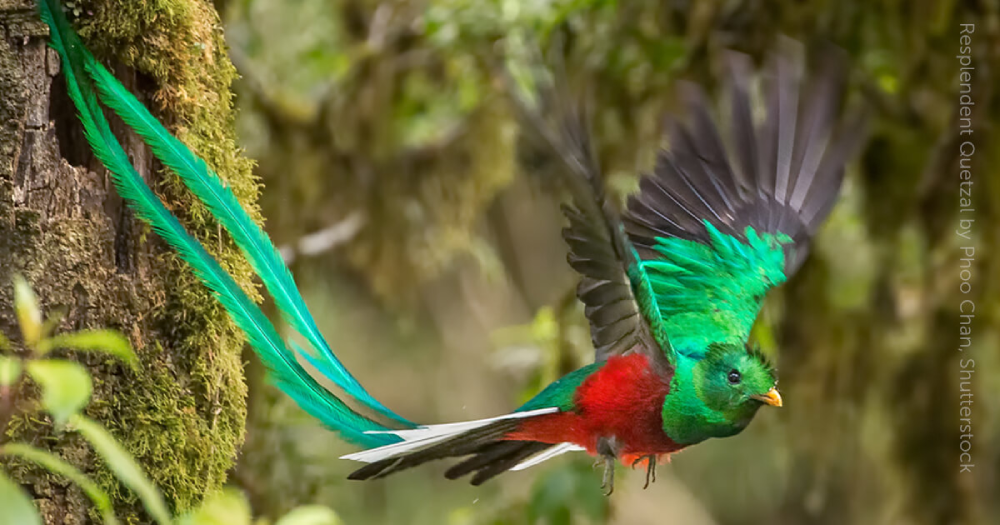The Resplendent Quetzal (Pharomachrus mocinno) is one of the most stunning and enigmatic birds in the world. Revered by ancient civilizations, celebrated in modern culture, and admired by ornithologists and birdwatchers alike, this bird embodies the delicate interplay between nature, culture, and conservation. Its vibrant plumage, ecological significance, and cultural legacy make the Resplendent Quetzal a symbol of natural beauty and biodiversity.
Physical Description
The Resplendent Quetzal is most renowned for its striking appearance. The males are particularly resplendent, with iridescent green plumage that can appear blue or gold depending on the light. Their vivid red bellies contrast sharply with the green, creating a spectacle of color that is almost otherworldly. One of the most distinguishing features of the male is its long, flowing tail feathers, which can extend up to three feet in length, trailing elegantly behind as it moves.
Females, while less flamboyant than their male counterparts, are still striking. They lack the long tail feathers but share the green and red coloration, though in a more subdued fashion. Both sexes have a distinctive crest of feathers on their heads, adding to their regal appearance.
Habitat and Distribution
The Resplendent Quetzal is primarily found in the cloud forests of Central America, from southern Mexico to Panama. These forests, situated at high altitudes with a perpetually misty and moist environment, provide the perfect habitat for the quetzals. The dense canopy, abundant fruit trees, and a plethora of insects create a rich ecosystem that sustains these birds.
Quetzals prefer to reside in elevations between 4,000 to 10,000 feet where the cloud forests thrive. The Monteverde Cloud Forest Reserve in Costa Rica is one of the most well-known habitats for quetzals, attracting numerous visitors hoping to catch a glimpse of this elusive bird.
Diet and Feeding Habits
Resplendent Quetzals are primarily frugivorous, with wild avocados (Lauraceae) being a staple of their diet. They swallow the small fruits whole and later regurgitate the pits, playing a crucial role in seed dispersal and the maintenance of forest diversity. Their diet also includes other fruits, insects, small frogs, and lizards, which they hunt with remarkable agility.
Their feeding behavior is closely linked to their habitat, as they rely on the dense canopy and the abundance of fruiting trees found in cloud forests. This specialization makes them particularly vulnerable to habitat loss.
Reproduction and Life Cycle
The breeding season for Resplendent Quetzals varies geographically but generally occurs between March and June. Males perform elaborate displays to attract females, showcasing their long tail feathers and engaging in acrobatic flights. Once a pair forms, they collaborate in building a nest, typically in a tree cavity or an old woodpecker hole.
Both parents share the responsibility of incubating the eggs and feeding the chicks. The chicks hatch after about 17 to 19 days and fledge the nest after roughly three weeks. The nurturing environment provided by the cloud forests is essential for the survival of the young quetzals.
Cultural Significance
The Resplendent Quetzal holds profound cultural significance, particularly among the indigenous peoples of Central America. The ancient Maya and Aztec civilizations revered the quetzal as a symbol of freedom and wealth. Its feathers were highly prized and often used in ceremonial headdresses and garments worn by royalty and priests. The bird’s name is derived from the Nahuatl word “quetzalli,” meaning “precious” or “sacred.”
The quetzal also features prominently in Mesoamerican mythology. It was believed to be the god of the air, a messenger between the gods and humans, and a symbol of the eternal cycle of life. Its image adorns various artifacts, from pottery to murals, attesting to its revered status.
In modern times, the quetzal remains an important symbol in Central America. It is the national bird of Guatemala and lends its name to the Guatemalan currency, the quetzal. The bird’s image appears on flags, coins, and stamps, representing the country’s natural heritage and the ongoing efforts to protect it.
Conservation Status and Threats
Despite its iconic status, the Resplendent Quetzal faces several threats that jeopardize its survival. Habitat loss due to deforestation, agricultural expansion, and urbanization is the most significant threat. The cloud forests, with their unique microclimate and biodiversity, are being rapidly diminished, reducing the available habitat for quetzals and other endemic species.
Climate change also poses a serious threat. Changes in temperature and precipitation patterns can alter the delicate balance of the cloud forests, affecting the availability of food and suitable nesting sites. These changes can have cascading effects on the entire ecosystem, further endangering the quetzal.
Illegal wildlife trade, though less common, still poses a threat. The allure of the quetzal’s vibrant plumage can make it a target for poaching, despite legal protections in place.
Conservation efforts are critical to the survival of the Resplendent Quetzal. Various initiatives focus on protecting and restoring cloud forest habitats, promoting sustainable agricultural practices, and fostering ecotourism that supports local economies while raising awareness about conservation issues. Organizations such as the Monteverde Conservation League and the Mesoamerican Biological Corridor project are actively working to create protected areas and biological corridors that ensure the quetzals and other species can thrive.
Conclusion
The Resplendent Quetzal is more than just a bird; it is a symbol of the rich natural and cultural heritage of Central America. Its breathtaking beauty, ecological importance, and deep cultural roots make it a powerful emblem for conservation efforts. Protecting the quetzal and its habitat is not only about preserving a species but also about maintaining the biodiversity and ecological health of one of the world’s most unique and precious ecosystems.
The story of the Resplendent Quetzal reminds us of the intricate connections between nature and culture and the shared responsibility we have to protect our planet’s natural wonders for future generations.










